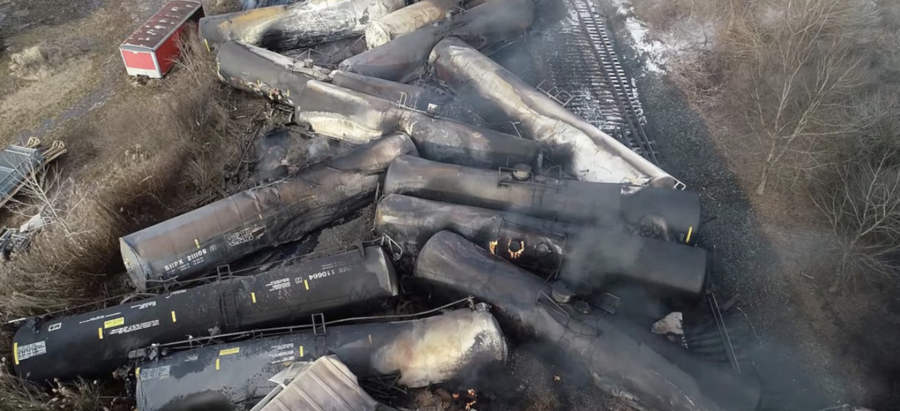CHE is cross-posting blogs from various experts responding to the tragic train derailment in Ohio on February 3, 2023. The following is an excerpt from a Toxic Free Future blog posted on February 17. You'll find the full version here.
The vinyl chloride train derailment in Ohio is a modern environmental disaster playing out in real time. Sadly, this is yet another painful reminder of the dangers of making, transporting, using, and disposing of chemicals in plastics, especially polyvinyl chloride (PVC) plastic.
PVC is widely considered to be the most toxic plastic from production to use to disposal. It’s most commonly used in building materials like PVC plastic piping and vinyl siding.
Thorough testing needed
This is not the first time an accident involving hazardous vinyl chloride has occurred. The U.S. Environmental Protection Agency (EPA) should be applying the lessons learned, particularly with comprehensive testing and monitoring of air, water, soil, farms and livestock, and homes.
One critical lesson is that EPA should be testing for dioxins, a highly hazardous class of chemicals.
We’ve seen elevated levels of dioxins released in industrial accidents involving chlorinated chemicals — from the explosion at the PVC plant in Illiopolis, Illinois to the Plastimet PVC recycling fire in Ontario. But without a comprehensive investigation, we will not know if dioxins are also a concern in the East Palestine vinyl chloride disaster.
Over the last week, EPA has repeatedly suggested that the disaster area is safe for residents to return home, but to date, EPA has not publicly released any data on dioxins, persistent chemicals that build up in the food chain and can cause cancer and other serious health problems. It appears that EPA has not yet conducted any sampling for dioxins.
This is deeply concerning, as we know that burning chlorinated chemicals like vinyl chloride, especially in uncontrolled conditions as was done in East Palestine, is a perfect recipe for dioxin formation.
It is critical that the EPA significantly expand the scope of its testing, with strong input from local communities, and launch a comprehensive multi-media investigation into the possible release of dioxins and other toxic byproducts from the disaster.
As a next step, the EPA should work with and seek input from the impacted communities to immediately develop and implement plans to:
- Test for dioxins and other byproducts in soils at homes, parks, schools, farms, and other locations
- Screen for dioxins and other byproducts in indoor dust
- Monitor dioxins and other byproducts in farm animals, milk, and eggs in farms downwind of the explosion
Among the most toxic chemicals on the planet
Other experts agree and are joining the call for an investigation into dioxins. For example, Cornell University soil and crop scientist Murry McBride recently stated:
“It is advisable that farmers and other residents in this area test their wells over the next few months at least for the presence of the spilled chemicals including vinyl chloride, in order to protect the health of humans and livestock. Because the combustion of vinyl chloride that resulted from the accident may have created highly toxic dioxins, surface soils downwind of the spill site should be tested for dioxin levels particularly where food crops are to be grown.”
Dioxins are a family of chemicals that are formed from the manufacture and burning of chlorinated chemicals, like those used to make PVC plastic. They are extremely persistent, bioaccumulative, and toxic.
As they are endocrine disruptors, they can be hazardous at incredibly low levels of exposure. And because they are persistent and bioaccumulative, they don’t go away for a very long time. The half-life of dioxins is estimated to be 7 to 11 years which means if someone has one part of dioxin in their body, it will take 7 to 11 years for half of it to degrade.
Dioxins are considered carcinogens by EPA, the International Agency for Research on Cancer, and the National Toxicology Program. They can also cause many non-cancer effects on our reproductive, developmental, and immune systems. They can also lead to chloracne, a rare skin eruption.
Dioxins are notorious for being the primary contaminant in Agent Orange, and other environmental tragedies like Love Canal and Times Beach. Will dioxins be found in the communities and farms downwind of the East Palestine derailment? Without testing, we won’t know. EPA must act now.
Preventing future disasters
Governments, retailers, and brands must redouble their efforts to phase out PVC plastic and other highly hazardous plastics and chemicals and move towards safer solutions.
In the meantime, for the health and well-being of communities, farmers, and workers downwind of this most recent disaster, EPA must move quickly to expand its investigation and sample for dioxins and other toxic byproducts that were likely released.
And if you're concerned about the communities impacted by the massive vinyl chloride train derailment at the Ohio/Pennsylvania border and want to know how you can help, here are some grassroots groups responding to the disaster you may want to connect with:


